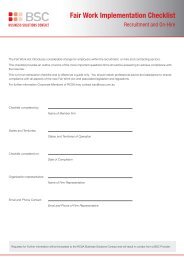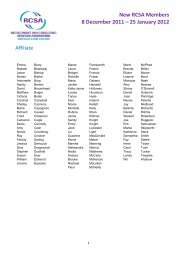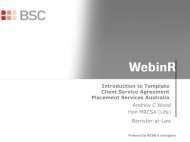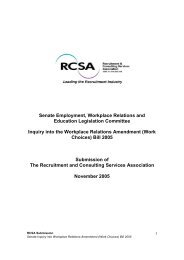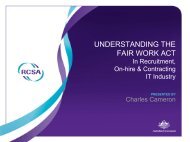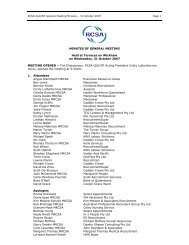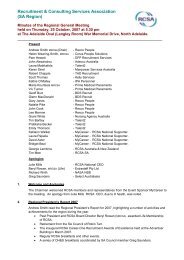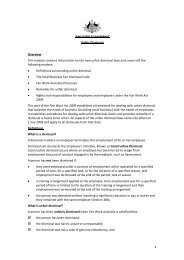June 2012.pdf - RCSA
June 2012.pdf - RCSA
June 2012.pdf - RCSA
You also want an ePaper? Increase the reach of your titles
YUMPU automatically turns print PDFs into web optimized ePapers that Google loves.
focus: RECRUITMENT AT THE SPEED OF TOMORROW<br />
Order-taker or trusted adviser<br />
Reframing the consultant’s role<br />
Recruiting at the<br />
speed of tomorrow<br />
means more than<br />
technology – it also<br />
means changing your<br />
thinking! Conference<br />
presenter Bridget<br />
Beattie looks at<br />
reframing the<br />
consultant’s role.<br />
No matter what the state of the market,<br />
every recruiter comes up against talent<br />
shortages at some point. Perhaps it’s a<br />
daily occurrence, or perhaps you are one of the<br />
lucky ones with a deep talent pool and plenty of<br />
great candidates.<br />
But regardless of the industry or skill set, sometimes<br />
you simply can’t find the right candidate. If it were<br />
easy, after all, clients could do their own recruitment!<br />
While every recruiter will struggle with hardto-place<br />
roles, it’s the way they respond that<br />
differentiates the outstanding recruiters from<br />
the middle-of-the-road ones.<br />
One response is to look further, deeper and<br />
wider for candidates. That is always an important<br />
part of your job. Clients expect you to be creative<br />
in the way you source talent, whether it’s through<br />
traditional networking, social media or<br />
sophisticated online searches.<br />
However, even the most thorough search<br />
sometimes fails to produce results. And this is<br />
when you have another option: change the brief!<br />
But isn’t that at odds with being a “consultant”<br />
Doesn’t it suggest that you can’t meet the needs<br />
of your client<br />
Not at all: true consulting is about working with<br />
the client to genuinely understand their needs; to<br />
get to the bottom of what they need to get the<br />
work done. By asking the right questions, you can<br />
drill down into the core competencies of a role<br />
– the “deal breakers” – as well as identify what can<br />
be taught, what is a “nice-to-have” and what the<br />
client can live without.<br />
The end result is that your B or C candidate<br />
can become an A, with the right training and<br />
development from their employer. In a world<br />
where specialist skills are in demand but hard<br />
to find – what we call the “talent mismatch” –<br />
finding a seventy per cent fit for a job is still a<br />
good outcome.<br />
If this is something your business already<br />
does – then you can stop reading in a moment.<br />
But firstly let me share some statistics from our<br />
database of candidates who undertake our career<br />
transition programs.<br />
Fewer than one in five of these candidates find<br />
a job through a recruiter, and one in three finds<br />
their job through networking. These are quality<br />
candidates – after participating in our programs,<br />
they are job-ready and have a clear understanding<br />
of their strengths. Yet recruiters are placing only<br />
one-fifth of them.<br />
This tells us two things:<br />
1. recruiters are missing out on good candidates<br />
by not pushing back on the client brief and<br />
2. candidates are better at selling themselves<br />
into clients than their recruiter.<br />
Despite the realities of the candidate market, it<br />
appears that many recruitment professionals still<br />
struggle to sell their less-than-100% candidates<br />
to clients – candidates who aren’t lacking in their<br />
attitude or ability; but who simply aren’t an exact<br />
match to the job specifications provided by the<br />
client.<br />
It’s a big pool of talent to rule out. If a client<br />
is insistent on only hiring someone from their<br />
particular industry, for example, they would<br />
miss out on around half of our candidates – the<br />
proportion who change industries during their<br />
career transition process. In fact, roughly the<br />
same proportion change functions too.<br />
These program participants are successful<br />
in making the leap, because they are adept at<br />
highlighting their transferable skills to employers.<br />
Are you doing the same thing for your candidates<br />
Setting up for success<br />
The challenge here is that getting a result for<br />
a client may depend on pushing back on their<br />
requests. It’s not something we like to do in<br />
professional services – after all, everyone likes<br />
making their clients happy.<br />
So how do you manage client expectations and<br />
move from being an order-taker to a consultant<br />
First of all, reframe your role. You’re not simply<br />
here to sell – you’re here to solve problems. That<br />
means asking lots of questions, being intellectually<br />
curious, understanding root causes and looking<br />
for patterns.<br />
This is also the point at which you have an<br />
opportunity to influence the design of the role,<br />
based on what is achievable in the market. Agree<br />
with the client upfront what would be appropriate<br />
as teachable fit: the core skills tend to be<br />
interpersonal – such as communication and<br />
problem solving – while the teachable parts<br />
are more likely to be hard skills.<br />
12<br />
<strong>RCSA</strong> JOURNAL



